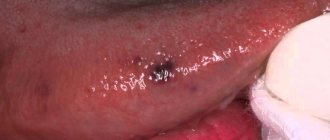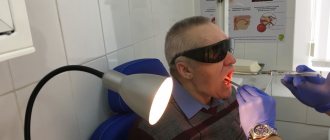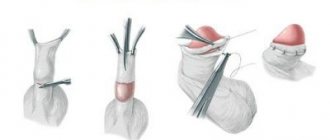Localization and type of lingual tonsils
The lingual tonsil can be singular or paired
The lingual tonsil is located under the surface of the back of the tongue. It is a formation of lymphoid tissue in which the process of maturation of immune cells and the production of antibodies occurs.
Despite the fact that it is designated as an unpaired organ, most people have two such tonsils. This is explained by the symmetrical division of the organ’s lymphoid tissue into two parts.
The lingual tonsil in the photo is determined by an accumulation of lymphoid tissue consisting of follicles, so its structure appears heterogeneous. To determine how many lingual tonsils a person has, it is enough to carefully examine the groove at the base of the tongue. If it is very clear and noticeable, it means that the lymphoid tissue is divided into two organs and two tonsils. Interestingly, this division is not a pathology.
The anatomy of the lingual tonsil is simple. Having figured out where the lingual or uvular tonsil is located, you should understand the functions that this organ performs. Along with the palatine tonsils, the lingual tonsil is an organ of the immune system, acting as a barrier to germs and viruses that enter the body through the mouth. When there is a threat of penetration of pathogenic microorganisms, immune cells are formed and released in this tonsil, designed to protect against the disease.
Stages
Depending on the size of the malignant tumor and the degree of its spread in the body, there are four stages of tonsil cancer:
- Stage I: a malignant tumor less than 2 cm in diameter that has not spread beyond the tonsil.
- Stage II: a malignant tumor 2–4 cm in diameter that has not spread beyond the tonsil.
- Stage III: A malignant tumor more than 4 cm in diameter that has spread to a lymph node in the neck on the affected side. The diameter of the lesion in the lymph node does not exceed 3 cm.
- Stage IV is diagnosed in one of four cases: cancer that has spread to adjacent organs and/or to more than one lymph node;
- cancer that has spread to one lymph node on the side of the malignant tumor, and the diameter of the lesion in the lymph node is more than 6 cm;
- cancer that has spread to the lymph node on the side opposite the location of the primary tumor;
- tonsil cancer with distant metastases.
Hypertrophy of the lingual tonsil
Under the influence of nicotine, the lingual tonsil becomes larger
Hypertrophy is the pathological growth of tissue, as a result of which the organ significantly increases in size. In fact, this is a type of tumor process that can be either benign or malignant. With hypertrophy of the lingual tonsil, an increase in neighboring organs of the lymphatic system is often observed, since they are all connected.
Hyperplasia is not always dangerous, but requires attention. Only a doctor after an examination can determine the degree of risk.
Reasons for the development of hypertrophy of the lingual tonsil:
- chronic inflammatory process in the palatine tonsils,
- inflammation of the lingual tonsil,
- undergone tonsillectomy,
- smoking,
- exposure to chemical compounds and harmful fumes,
- genetic predisposition,
- human papilloma virus.
What are the indications for adenoid removal (adenotomy)?
Adenotomy
- Cost: 50,000 - 80,000 rubles.
More details
- Poor nasal breathing during the period when the child is healthy. This is dangerous because the child’s body experiences hypoxia (oxygen starvation). Insufficient oxygen supply to the body can lead to a delay in the psychomotor development of the child; the child may be adynamic, or, conversely, hyperactive. Due to the fact that the child constantly breathes through his mouth, the facial skeleton (adenoid face) is formed incorrectly. The quality of life of such children certainly suffers.
- Hearing loss or frequent inflammation in the ears are also direct indications for adenotomy. The mechanism of occurrence of this pathology occurs as follows. Where the adenoids are located, there is the mouth of the auditory tube (Eustachian tube) - an organ that connects the middle ear (what is located behind the membrane) and the nasopharynx itself. If, with your mouth closed, you pinch the tip of your nose and exhale into your nose, then air will enter your ears due to this very organ. Due to the close anatomical location of the adenoids and the auditory tubes, the inflammatory process from the adenoids can move to the mouth of the auditory tubes, causing in turn inflammation and, as a consequence, dysfunction of the auditory tube. In addition to the chronic inflammatory process in the auditory tubes, when adenoids grow, they can cover the mouths of the auditory tubes, leading to the development of adhesive otitis media or the formation of exudative otitis media (fluid in the middle ear). Frequent purulent-inflammatory phenomena in the cavity of the middle ear (sound transmitting apparatus) lead to the formation of adhesions and scars between the auditory ossicles, which subsequently leads to hearing loss in adulthood. In these cases, between the organ of hearing and the natural filter in the form of adenoids, we choose the organ of hearing.
- It is also necessary to part with adenoids if the child often suffers from adenoiditis, which, with local treatment, does not produce significant positive dynamics, but only leads to recovery for a short period of time. This is a consequence of the fact that the adenoids do not carry out their immune function, they have worn out themselves as a natural filter, are a source of chronic infection and need to be sanitized (removed). Adenoiditis can also often be associated with herpes viral infection (Epstein-Barr virus, cytomegalovirus, type 6 virus), which live in the lymphoid tissue, leading to a decrease in immunity, including local immunity. If your child suffers from ARVI more than 6 times a year, there is cervical lymphadenitis (enlarged lymph nodes), conservative treatment of adenoiditis helps for a short time, in this case you need to contact a pediatrician for further examination for a herpes viral infection. When this group of viruses is detected, adequate treatment is prescribed, and if positive dynamics are observed in the adenoids during therapy, the child should be observed and there is no need to rush into surgery.
But if, together with treatment from a pediatrician, no effect is observed, then, according to the law of surgery, the tissue that prevents a person from living is removed.
Inflammation of the lingual tonsil
The disease can appear if you are very cold
The cause of inflammation of the lingual tonsil in the vast majority of cases are staphylococci and streptococci. As is known, these same pathogens provoke acute tonsillitis. In the vast majority of cases, the development of inflammation of the lingual tonsil is caused by a decrease in general and local immunity. The fact is that strong immune defense successfully copes with opportunistic bacteria, which are staphylococci.
Symptoms of tonsil cancer
In the early stages there are often no symptoms. In the future, the following complaints may arise:
- pain in the throat, mouth;
- enlargement of the affected tonsil - can be detected during examination of the throat;
- blood in saliva;
- sensation as if something were stuck in the back of the throat;
- difficulty chewing, swallowing, talking;
- swelling, pain in the neck;
- severe pain in the ear;
- pain while swallowing;
- bad breath.
The listed symptoms are nonspecific; they do not indicate that cancer will definitely be diagnosed. This could be inflammation of the tonsils or another disease. Only a doctor can make an accurate diagnosis. If you experience similar symptoms, you need to visit an ENT doctor.
We will call you back, leave your phone number
Message sent!
expect a call, we will contact you shortly
Treatment methods
If you feel discomfort in your throat and do not notice the symptoms of typical tonsillitis, you should consult a doctor as soon as possible. The doctor will be able to examine the patient’s throat in detail and make a diagnosis. Additionally, blood tests and a throat swab may be required.
Based on the examination results, the doctor selects a treatment regimen. For inflammation of the tonsil, conservative therapy is practiced; for hypertrophy, surgical therapy is used.
Drug treatment
The tablet is taken both before and after meals (it is recommended to take it with plenty of water)
Treatment begins with determining the cause of the disease. Both inflammation and hypertrophy are initially treated in the same way. Therapy consists of:
- antiseptic gargles,
- taking antipyretic and painkillers,
- antiviral, antifungal or antibacterial therapy.
A throat swab and blood test can determine the causative agent of the disease. For bacterial infections, broad-spectrum antibiotics are prescribed. They should be taken according to the doctor's recommendations; self-medication is unacceptable.
If the disease is viral in nature, for example, human papillomavirus or herpes, the drugs Acyclovir, Zovirax and their analogues are prescribed. These medications stop the activity of the virus and boost the immune system, helping it fight the disease.
Fungal infection of the lingual tonsil is quite rare, but such a disease can be completely excluded only after tests. If the cause is a fungal infection, the drugs Fluconazole, Itraconazole or Nystatin tablets are prescribed.
Angina
Sore throat is an acute inflammation of the tonsils and pharyngeal mucosa. Angina ranks third among all diseases in terms of the number of days of disability (after influenza and acute respiratory infections), with 75% of patients under 30 years of age. According to clinical data and pharyngoscopic picture, angina is distinguished: catarrhal, follicular, lacunar, ulcerative-membranous, necrotic.
CLASSIFICATION according to etiology:
- nonspecific flora (main): - streptococcus (hemolytic streptococcus group A), epidemic streptococcus) - staphylococcus: a) aureus, b) white - pneumococcus - coli: a) intestinal b) pseudomonas - proteus.
- for acute infectious diseases (diphtheria, scarlet fever, measles, rubella, influenza and adenoviruses, glanders, brucellosis, tularemia).
- infectious granulomas and specific pathogens (tuberculosis, syphilis, candidomycosis).
- for blood diseases and hemorrhagic diathesis (leukemia (lymphocytic leukemia), agranulocytosis, infectious mononucleosis, nutritional toxic aleukia).
CLINIC. Angina manifests itself clinically in the form of catarrhal, follicular and lacunar tonsillitis.
Nonspecific angina : catarrhal, when only the mucous membrane of the tonsils is affected, follicular - purulent damage to the follicles, lacunar - pus accumulates in the lacunae.
Sore throat caused by adenoviruses: occurs in the form of diffuse acute pharyngitis. Adenovirus infection is characterized by widespread damage to the lymph nodes and a very frequent combination with conjunctivitis.
Acute inflammation of the tonsils of another localization:
• Sore throat of the lingual tonsil - characteristic symptoms: pain in the deep parts of the pharynx, sharply intensifying when trying to stick out the tongue. The diagnosis is made easier by resorting to indirect laryngoscopy.
• Sore throat of the nasopharyngeal tonsil - pain is localized in the nasopharynx, thick mucous discharge from the nose, acute runny nose is noted
• Sore throat of the lateral ridges (acute lateral pharyngitis) or sore throat of the granules of the pharynx (acute granulosa pharyngitis)
• Laryngeal tonsillitis - inflammation of the lymphoid tissue of the pharynx.
Inflammation of the cellular spaces of the neck in the pharynx area:
• phlegmonous tonsillitis or peritonsillar abscess
• parapharyngeal abscess
• retropharyngeal abscess
• phlegmon of the floor of the mouth (Ludwig's tonsillitis).
Sore throat as a syndrome of common infectious diseases.
a) sore throat with scarlet fever (usually catarrhal (erythematous) and lacunar (mushy)). There are severe forms of scarlet fever, occurring in the form of:
• pseudomembranous tonsillitis with the formation of fibrinous exudate distributed on the mucous membrane of the tonsils, pharynx, nasopharynx and even cheeks in the form of a thick grayish film tightly fused to the underlying tissue.
• ulcerative-necrotic tonsillitis - characterized by the appearance of grayish spots on the mucous membrane, quickly turning into ulcers. Deep ulceration may occur with the formation of permanent defects of the soft palate. The lateral cervical lymph nodes are affected by extensive inflammation.
• gangrenous tonsillitis (rare).
b) sore throat due to diphtheria (occurs in various clinical forms). Strict limit of plaque spread within the tonsils.
c) sore throat due to measles (occurs under the guise of catarrhal disease in the prodromal period and during the period of rash).
d) sore throat with influenza (proceeds as catarrhal, but it is more correct to talk about acute pharyngitis, since diffuse hyperemia affects the tonsils, arches, uvula, and back wall of the pharynx).
e) erysipelas is a serious disease, often occurring together with erysipelas of the face. Severe pain when swallowing.
f) sore throat with tularemia (may resemble catarrhal or more often membranous tonsillitis, mistakenly diagnosed as diphtheria).
Sore throat in blood diseases.
a) monocytic tonsillitis (infectious mononucleosis, or Filatov’s disease)
b) agranulocytic tonsillitis
DIAGNOSTICS - anamnesis and clinical picture, blood test, throat smear, computed tomography of the chest, pharyngoscopy.
TREATMENT
- nonspecific sore throats - drug treatment
- with the development of purulent complications - surgical (operative)
Prevention
Leading a healthy lifestyle is one of the main rules
To avoid diseases of the lingual tonsil, it is necessary to strengthen the immune system. All methods are suitable for this - from hardening to taking vitamins. However, no preventive measures will work if there is a chronic source of infection in the body. First of all, you need to cure your teeth, chronic tonsillitis and other advanced diseases. Smokers should give up smoking, otherwise sooner or later chronic diseases of the tonsils will appear, including tissue hypertrophy.
If you suspect inflammation of the lingual tonsil, you should consult a doctor and not self-medicate. An advanced inflammatory process is dangerous due to an abscess of the lingual tonsil and inflammation of the lymph nodes.
Forecast
The main factors influencing the prognosis for tonsil cancer:
- Stage of the disease. The more a malignant tumor has spread in the body, the more difficult it is to fight it.
- Age. Patients under 40 years of age have higher survival rates.
- General health. With severe concomitant diseases, the prognosis worsens.
- Presence of HPV in cancer cells. Such tonsil tumors are treated more successfully.
- Smoking. People who continue to smoke during treatment have a higher risk of complications. The same goes for drinking alcohol.
Overall 5-year survival rates (proportion of patients alive 5 years after diagnosis) for oropharyngeal malignancies:
- cancer that has not spread beyond the affected organ - 84%;
- cancer that has spread to neighboring tissues and regional lymph nodes - 66%;
- cancer with metastases - 39%.
At the Medica24 International Clinic you can receive effective treatment for tonsil cancer and other malignant tumors of the head and neck at any stage. Our doctors perform surgical interventions of any degree of complexity in an operating room equipped with modern equipment, and conduct antitumor therapy with the latest drugs in accordance with international protocols.
The material was prepared by Pavel Aleksandrovich Nasilevsky, an oncologist at the International Clinic Medica24.











